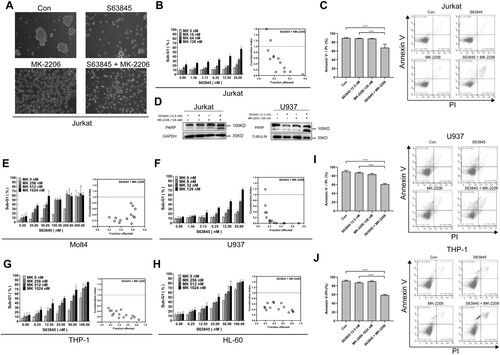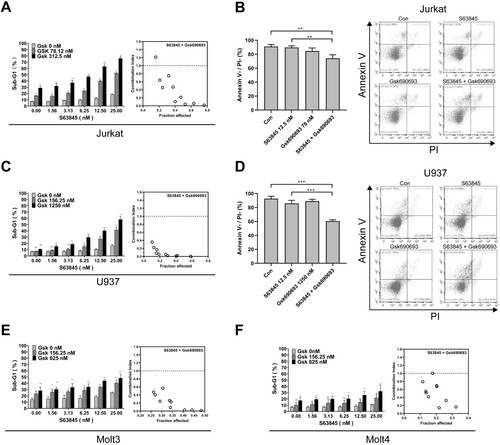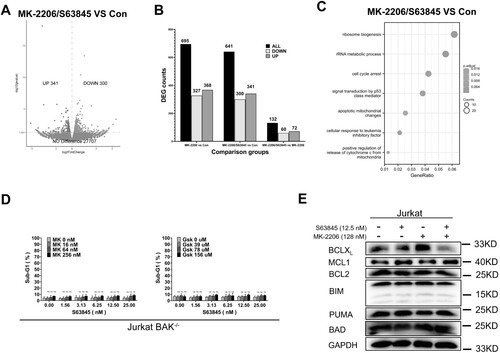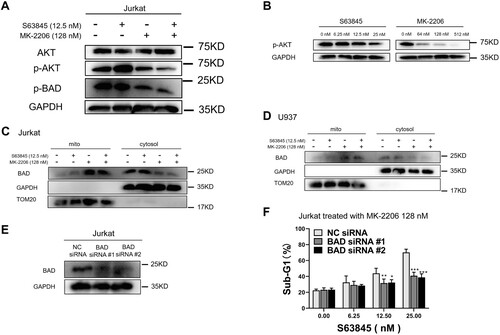Figures & data
Figure 1. MK-2206 promotes S63845-induced apoptosis in multiple leukemia cell lines. (A) After Jurkat cells were treated with DMSO (Con), S63845 (12.5 nM), MK-2206 (128 nM), or S63845 (12.5 nM) + MK-2206 (128 nM), the images of the cells were taken under microscopy. (B, E–H) After Jurkat cells (B), Molt4 (E), U937 (F), THP.1 (G) or HL-60 cells (H) were treated with indicated concentrations of S63845 in combination with MK-2206 for 24 h, the cells were subjected to flow cytometry analysis for sub-G1 cells. Summary data from three independent experiments are shown. Right panels, combination indexes were calculated. (C, I-J) After Jurkat cells (C), U937 (I) or THP.1 cells (J) were treated with indicated concentrations of S63845 in combination with MK-2206 for 24 h, the cells were subjected to Annexin V/PI double staining and assessed by flow cytometry. Summary data from three independent experiments (left panels) and a representative experiment (right panels) are shown. (D) After Jurkat (left) or U937 (right) cells were incubated with control, S63845 (12.5 nM) alone, MK-2206 (128 nM) alone, or their combination for 24 h, whole cell lysates were prepared and subjected to immunoblotting with antibodies against PARP and GAPDH. Data in B, C and E–J represent mean ± SD from three independent experiments. Differences between groups in this figure, the following figures and supplementary figures were determined by ANOVA. *, p < 0.05; **, p < 0.01; ***, p < 0.001; and ns, not significant.

Figure 2. Gsk690693 promotes S63845-induced apoptosis in multiple leukemia cell lines. (A, C, E–F) After Jurkat cells (A), U937 (C), Molt3 (E) or Molt4 cells (H) were treated with indicated concentrations of S63845 in combination with Gsk690693 (Gsk) for 24 h, the cells were subjected to flow cytometry analysis for sub-G1 cells. Summary data from three independent experiments are shown. Right panels, combination indexes were calculated. (B, D) After Jurkat cells (B), or U937 (D) were treated with indicated concentrations of S63845 in combination with Gsk690693 for 24 h, the cells were subjected to Annexin V/PI double staining and assessed by flow cytometry. Summary data from three independent experiments (left panels) and a representative experiment (right panels) are shown.

Figure 3. MK-2206 sensitizes to S63845-induced apoptosis through the mitochondrial apoptotic pathway. (A) After Jurkat cells were treated with solvent (Con), MK-2206 (128 nM), or S63845 (12.5 nM)/MK-2206 (128 nM) combination, cells were collected and subjected to transcriptome analysis. Volcano plot of upregulated and downregulated differentially expressed genes (DEGs) of MK-2206/S63845 vs Con were shown. (p value < 0.05 was used to select the DEGs.) (B) DEGs between MK-2206 vs. Con group, MK-2206/S63845 combination vs. Con group, and MK-2206/S63845 combination vs. MK-2206 group were shown. (C) KEGG enrichment analysis using the changed DEGs from S63845/MK-2206 combination vs Con. (D) After BAK−/− Jurkat cells were treated with of indicated concentration of S63845 in combination with MK-2206 (left panel) or Gsk690693 (right panel) for 24 h, the cells were subjected to flow cytometry analysis for sub-G1. (E) After Jurkat cells were incubated with control, S63845 (12.5 nM) alone, MK-2206 (128 nM) alone, or their combination for 24 h, whole cell lysates were subjected to immunoblotting with the indicated antibodies. A representative experiment from three independent experiments is shown. Data in D are presented as mean ± SD from three independent experiments.

Figure 4. BAD dephosphorylation and translocation induced by MK-2206 is essential for MK-2206-induced sensitization to S63845 in Jurkat cells. (A) After Jurkat cells were incubated with control, S63845 (12.5 nM) alone, MK-2206 (128 nM) alone, or their combination for 24 h, whole cell lysates were prepared and subjected to immunoblotting with antibodies against AKT, p-AKT (Ser473), p-BAD (Ser99) and GAPDH. (B) After Jurkat cells were incubated with increased concentrations of S63845 or MK-2206, whole cell lysates were prepared and subjected to immunoblotting with antibodies against p-AKT (Ser473) and GAPDH.(C-D) 24 h after Jurkat cells (C) or U937 cells (D) were treated with control, S63845 (12.5 nM) alone, MK-2206 (128 nM) alone, or their combination, the indicated cellular fractions were isolated and subjected to immunoblotting for BAD, TOM20 or GAPDH. (E) 24 h after Jurkat cells were transiently transfected with Control or BAD siRNAs, whole cell lysates were subjected to immunoblotting. (F) 24 h after Jurkat cells were transfected with Control siRNA or BAD siRNA (E), cells were treated with 128 nM MK-2206 with or without S63845 (0–25 nM) for another 24 h, then cells were subjected to flow cytometry analysis for sub-G1. Data in F is presented as mean ± SD from three independent experiments.

Supplemental Material
Download PDF (185.9 KB)Data availability statement
This study includes no data deposited in external repositories. All the raw data reported in this paper will be shared by the lead contact upon request.
